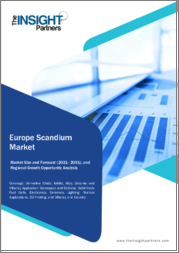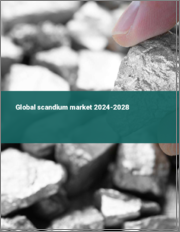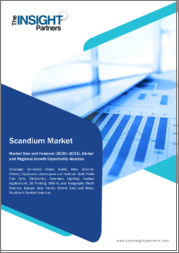
|
시장보고서
상품코드
1804479
스칸듐 포일 시장 : 제품 유형, 두께, 형상, 유통 채널, 용도별 - 세계 예측(2025-2030년)Scandium Foil Market by Product Type, Thickness, Form, Distribution Channel, Applications - Global Forecast 2025-2030 |
||||||
스칸듐 포일 시장은 2024년에는 2억 6,791만 달러로 평가되었으며, 2025년에는 2억 9,508만 달러, CAGR 10.52%로 성장하여 2030년에는 4억 8,847만 달러에 달할 것으로 예측됩니다.
| 주요 시장 통계 | |
|---|---|
| 기준 연도 2024년 | 2억 6,791만 달러 |
| 추정 연도 2025년 | 2억 9,508만 달러 |
| 예측 연도 2030년 | 4억 8,847만 달러 |
| CAGR(%) | 10.52% |
스칸듐 포일의 주요 물리적 특성, 새로운 용도, 기술 혁신에 미치는 영향에 초점을 맞추고 산업에서 스칸듐 포일의 전략적 역할을 탐구합니다.
스칸듐 포일은 초경량, 고강도 금속판으로 등장하여 기존 합금과 차별화된 뛰어난 내식성, 용접성, 열 안정성을 제공합니다. 그 결정 구조는 가혹한 조건에서 독특한 성능을 발휘합니다. 역사적으로 비용의 제약과 한정된 공급으로 인해 고도로 특수한 용도로만 사용되어 왔습니다. 그러나 최근 광석 채굴, 전해액 정제, 포일 압연 방법의 기술적 진보로 인해 보다 폭넓은 활용이 가능해졌습니다. 이러한 기술 혁신은 경량화와 내구성이라는 이중의 요구가 중요해진 항공우주, 전자, 에너지 등의 분야에서 르네상스를 주도하고 있습니다. 또한, 포일은 합금과 호환되므로 개발자는 기계적 특성을 정확하게 설계할 수 있으며, 까다로운 사용 사례에서 엄격한 사양을 충족할 수 있습니다.
공급망 재편, 정교한 생산 방식 및 기술 혁신이 스칸듐 포일 산업의 경쟁 역학을 재구성하는 방법
새로운 공급망 재편으로 스칸듐 광석의 조달, 정제, 운송 방법을 재조정하기 시작했습니다. 북미의 채굴업체와 가공 공장 간의 새로운 제휴로 공급처가 다양화되는 한편, 물류 네트워크는 강화된 추적성 및 위험 관리 프로토콜을 채택하고 있습니다. 동시에, 전해 침전 및 롤 본딩을 개선하여 에너지 소비를 줄이고 불순물 수준을 낮추며 보다 효율적인 생산 방법을 도입했습니다. 첨가제 제조 및 첨단 코팅 기술의 기술적 도약은 포일의 기능 범위를 확장하고 이전에는 실현 불가능했던 용도를 실현하고 있습니다.
스칸듐 포일 수입에 대한 2025년 미국 관세 개정이 어떻게 비용 구조를 재구성하고 이 부문의 전략적 조달 결정을 유도하는지 평가합니다.
2025년 스칸듐 포일 수입에 대한 미국의 개정 관세 도입은 여러 업계의 비용 구조와 전략적 조달 결정을 통해 파장을 불러일으키고 있습니다. 수입 포일에 의존하는 제조업체는 투입 비용 상승에 직면하여 공급업체와의 계약을 재검토하고 지역 대안을 검토하도록 촉구했습니다. 동시에 국내 제조업체들은 일시적인 유예를 경험하고, 이 정책 전환을 이용하여 생산능력에 대한 투자 및 최종사용자와의 장기 계약 협상을 진행하였습니다. 이러한 역학관계는 무역장벽이 높아짐에 따라 재고를 줄이고자 하는 욕구와 공급을 지속해야 하는 필요성의 균형을 맞추기 위해 재고 관리 관행을 재평가하도록 유도하고 있습니다.
제품 유형, 두께 범위, 구성 형태 및 용도 구분이 포일에 대한 고유한 성능 요구 사항과 성장 패턴을 촉진하는 방법
스칸듐 포일의 상황은 제품 유형과 두께라는 렌즈를 통해 보면 뚜렷한 특징을 보입니다. 순수 스칸듐 포일은 최대 순도와 최소의 오염물질 수준을 우선시하는 용도와 공명하여 고성능 항공기 부품 및 특수 반도체에 선택되는 원동력이 되고 있습니다. 반면, 알루미늄이나 마그네슘과 같은 적합한 금속으로 강화된 스칸듐 합금 포일은 인장 강도와 비용 효율성의 매력적인 균형을 제공하여 자동차 열교환기 및 에너지 인프라의 보호 코팅에 선호되는 선택이 되고 있습니다. 0.1mm 이하의 초박형 게이지는 LED 조명 및 의료용 영상 장비에 뛰어난 유연성을 제공하며, 0.1-1mm의 중간 두께는 구조용과 전자제품을 혼합하여 사용할 수 있는 다용도성을 제공합니다. 시트와 롤은 간소화된 생산 라인에 표준화된 옵션을 제공하고, 맞춤형 절단 구성은 맞춤형 엔지니어링 애플리케이션에서 정밀한 피팅을 가능하게 합니다.
아메리카, 유럽, 중동 및 아프리카, 아시아태평양을 비교하여 각 지역의 차이가 포일 사용 패턴, 공급 결정, 경쟁 우선순위를 어떻게 형성하는지 밝힙니다.
아메리카는 풍부한 광물 자원과 탄탄한 야금 인프라를 바탕으로 스칸듐 포일의 세계 공급망을 지속적으로 뒷받침하고 있습니다. 북미의 정유사들은 생산능력을 확장하고 물류 효율성을 활용하여 국내 항공우주 제조업체와 급성장하는 에너지 기업에 서비스를 제공하고 있습니다. 반면, 남미 사업은 원가경쟁을 중시하고 유리한 채굴 경제성과 다운스트림 가공업체와의 새로운 합작투자를 활용하고 있습니다. 이러한 지역적 강점은 미국의 첨단 방위 산업부터 브라질의 태양광 패널 조립 프로젝트까지 다양한 수요 프로파일을 뒷받침하고 있습니다.
스칸듐 포일 분야의 기술 혁신, 전략적 제휴, 생산능력 확대를 주도하는 주요 기업들을 집중 조명합니다.
스칸듐 포일 분야의 주요 기업들은 연구개발에 대한 집중적인 투자를 통해 학계 및 전문 기술 기업과의 협력 관계를 구축하여 두각을 나타내고 있습니다. 일부 제조업체들은 전해침전 설비를 확장하고, 강도 대 중량비를 최적화하는 합금 조성을 개선하면서 더 높은 처리 능력을 지원하고 있습니다. 적층 가공 분야의 선두 기업과의 전략적 제휴를 통해 포일을 차세대 부품 아키텍처에 통합하는 독자적인 소재를 개발하여 국방 하드웨어 및 전자 모듈의 모듈식 설계를 위한 길을 열었습니다. 동시에 일부 조직은 후방 통합을 추구하고, 중요한 원료 공급을 확보하고, 조달 비용을 안정화하기 위해 업스트림 광산 벤처의 소수 지분을 인수하기도 했습니다.
공급 탄력성을 강화하고, 공동 혁신을 촉진하고, 진화하는 포일 산업 상황에 맞게 제품 전략을 맞춤화할 수 있는 실행 가능한 단계를 제공합니다.
공급망의 탄력성을 강화하기 위해 조직은 여러 지역에 걸친 다양한 공급업체 네트워크를 육성하고 재활용 스칸듐의 흐름을 통합해야 합니다. 업스트림 광물 가공업체와 다운스트림 가공업체 모두와 전략적 파트너십을 구축함으로써 기업은 정책 변화나 물류 혼란으로 인한 리스크를 줄일 수 있습니다. 동시에, 고급 수요 예측 도구와 결합된 효율적인 재고 관행에 투자함으로써 서비스 수준을 희생하지 않고도 변동에 민첩하게 대응할 수 있습니다.
스칸듐 포일 부문에 대한 인사이트를 얻기 위해 활용된 종합적인 조사 프레임워크, 데이터 수집 및 분석 방법론에 대한 자세한 정보 제공
본 Executive Summary의 기초가 되는 분석은 광범위한 2차 데이터 검토와 타겟팅된 1차 조사를 결합한 다층적 조사 프레임워크에 기반하고 있습니다. 2차 조사에서는 스칸듐 추출, 박막 기술, 합금 특성 평가와 관련된 기술 논문, 산업 잡지, 정부 간행물 등을 종합적으로 조사했습니다. 이러한 배경에서 주요 재료 특성, 제조 기술, 최종 용도의 성능 기준에 대한 기초적인 이해를 얻을 수 있었습니다.
스칸듐 포일 산업의 현재와 미래의 윤곽을 정의하는 중요한 인사이트, 변혁적 동향, 전략적 기회 요약
이 주요 요약은 오늘날 스칸듐 포일의 상황을 정의하는 매우 중요한 요인을 강조했습니다. 공급망 전략과 생산 방식의 혁신적 변화부터 2025년 미국 관세 개정의 미묘한 의미에 이르기까지, 이 분석은 비용 구조와 조달 결정이 정책적 프레임워크와 어떻게 교차하는지를 보여줍니다. 세분화 인사이트는 다양한 제품 유형, 두께 범위 및 응용 분야가 성능 요구 사항과 성장 잠재력을 촉진하는 방법을 보여줍니다. 지역별 관점에서는 아메리카, 유럽, 중동 및 아프리카, 아시아태평양의 다양한 자원 공급과 규제 환경으로 인한 전략적 기회를 강조하고 있습니다.
목차
제1장 서문
제2장 조사 방법
제3장 주요 요약
제4장 시장 개요
제5장 시장 역학
제6장 시장 인사이트
- Porter's Five Forces 분석
- PESTEL 분석
제7장 미국 관세의 누적 영향 2025년
제8장 스칸듐 포일 시장 : 제품 유형별
- 순수 스칸듐 포일
- 스칸듐 합금 포일
제9장 스칸듐 포일 시장 : 두께별
- 0.1mm-1mm
- 1mm 이상
- 0.1mm 이하
제10장 스칸듐 포일 시장 : 형상별
- 커스텀 컷
- 롤
- 시트
제11장 스칸듐 포일 시장 : 유통 채널별
- 오프라인
- 온라인
제12장 스칸듐 포일 시장 : 용도별
- 항공우주 부품
- 항공기 구조 부품
- 패스너
- 기체
- 방위 및 군 용도
- 일렉트로닉스 및 반도체 기판
- 메모리 셀 코팅
- 스퍼터링 타겟
- 에너지
제13장 아메리카의 스칸듐 포일 시장
- 미국
- 캐나다
- 멕시코
- 브라질
- 아르헨티나
제14장 유럽, 중동 및 아프리카의 스칸듐 포일 시장
- 영국
- 독일
- 프랑스
- 러시아
- 이탈리아
- 스페인
- 아랍에미리트
- 사우디아라비아
- 남아프리카공화국
- 덴마크
- 네덜란드
- 카타르
- 핀란드
- 스웨덴
- 나이지리아
- 이집트
- 튀르키예
- 이스라엘
- 노르웨이
- 폴란드
- 스위스
제15장 아시아태평양의 스칸듐 포일 시장
- 중국
- 인도
- 일본
- 호주
- 한국
- 인도네시아
- 태국
- 필리핀
- 말레이시아
- 싱가포르
- 베트남
- 대만
제16장 경쟁 구도
- 시장 점유율 분석, 2024년
- FPNV 포지셔닝 매트릭스, 2024년
- 경쟁 분석
- ESPI Metals
- Goodfellow Cambridge Ltd.
- American Elements Inc.
- Avantor, Inc.
- Central Drug House Pvt. Ltd.
- CG Material
- ChangSha Zegen Advanced Materials Limited
- Chemazone Inc.
- EdgeTech Industries LLC
- Heeger Materials Inc.
- Hunan Oriental Scandium Co., Ltd.
- IREL(India) Limited
- LTS Research Laboratories, Inc.
- Merck KGaA
- Metalysis Ltd.
- Nilaco Corporation
- QS Advanced Materials Inc
- QS Advanced Materials Inc
- Reade International Corp.
- Scandium International Mining Corp.
- Solvay SA
- Stanford Advanced Materials
- Super Conductor Materials, Inc.
- Thermo Fisher Scientific Inc.
- Viridis Materials LLC
제17장 리서치 AI
제18장 리서치 통계
제19장 리서치 컨택트
제20장 리서치 기사
제21장 부록
KSM 25.09.10The Scandium Foil Market was valued at USD 267.91 million in 2024 and is projected to grow to USD 295.08 million in 2025, with a CAGR of 10.52%, reaching USD 488.47 million by 2030.
| KEY MARKET STATISTICS | |
|---|---|
| Base Year [2024] | USD 267.91 million |
| Estimated Year [2025] | USD 295.08 million |
| Forecast Year [2030] | USD 488.47 million |
| CAGR (%) | 10.52% |
Exploring the strategic role of scandium foil in industries by highlighting its key physical qualities, emerging applications, and influence on innovation
Scandium foil emerges as an ultralight, high-strength metal sheet, offering exceptional corrosion resistance, weldability, and thermal stability that set it apart from conventional alloys. Its crystalline structure confers unique performance benefits under extreme conditions. Historically, cost constraints and limited supply have narrowed its use to highly specialized applications. Recent technological advancements in ore extraction, electrolyte refinement, and foil rolling methods, however, are unlocking broader access. These innovations are driving a renaissance in sectors such as aerospace, electronics, and energy, where the dual imperatives of weight reduction and durability have become critical. Additionally, the foil's compatibility with tailored alloying enables developers to precisely engineer mechanical properties, meeting stringent specifications across demanding use cases.
This executive summary provides an overview of the fundamental factors shaping current adoption of scandium foil. It highlights transformative industry shifts in supply chains and production processes, evaluates the implications of recent U.S. tariff revisions, and examines granular segment dynamics. In addition, the summary synthesizes regional perspectives, spotlights leading companies' strategic initiatives, and offers actionable recommendations to guide decision makers. By distilling extensive research into clear, concise insights, this document lays the groundwork for informed strategic planning and investment prioritization in the evolving scandium foil arena.
How supply chain realignments, refined production methods, and technological breakthroughs are reshaping competitive dynamics within the scandium foil industry
Emerging supply chain realignments have begun to recalibrate the way scandium ore is sourced, refined, and transported. New partnerships between mining operators and processing plants in North America are diversifying sources, while logistics networks adopt enhanced traceability and risk management protocols. At the same time, refinements in electrolytic deposition and roll bonding have introduced more efficient production methods that reduce energy consumption and lower impurity levels. Technological breakthroughs in additive manufacturing and advanced coating techniques are expanding the foil's functional envelope, unlocking applications that were previously infeasible.
Regulatory frameworks focused on critical minerals have gained momentum, encouraging localized production and incentivizing vertical integration strategies. These policy developments, coupled with growing sustainability mandates, pressure industry participants to adopt greener practices and secure stable supplies of high-purity scandium. As a result, the competitive landscape is tilting in favor of innovators capable of bridging scale with sustainability. Forward-thinking stakeholders are leveraging emerging digitalization tools and collaborative research platforms to capitalize on these transformative currents, positioning themselves to lead the next wave of growth and resilience in the foil sector.
Evaluating how 2025 U.S. tariff revisions on scandium foil imports are reshaping cost structures and guiding strategic sourcing decisions within the sector
The introduction of revised U.S. tariffs on scandium foil imports in 2025 has sent ripple effects through cost structures and strategic sourcing decisions across multiple industries. Manufacturers reliant on imported foil have faced elevated input costs, prompting them to reevaluate supplier agreements and explore regional alternatives. At the same time, domestic producers have experienced a temporary reprieve, using the policy shift to invest in capacity and negotiate long-term contracts with end users. These dynamics have provoked a reassessment of inventory management practices, as organizations balance the desire for lean stock levels against the need for supply continuity in a climate of rising trade barriers.
Downstream industries such as aerospace and defense have responded by diversifying material portfolios, incorporating alloyed variants and exploring hybrid laminates in order to mitigate exposure to tariff-induced price volatility. Electronics manufacturers are experimenting with lower-gauge foil formats to preserve performance while controlling costs. Energy sector participants have reconsidered project timelines, integrating tariff variables into feasibility analyses for fuel cell and solar component initiatives. In this environment, strategic agility and proactive policy monitoring have become indispensable capabilities for stakeholders seeking to navigate the compounded implications of tariff adjustments on global scandium supply chains.
How product type distinctions, thickness ranges, configuration forms, and application segments drive unique performance demands and growth patterns in foil
The scandium foil landscape exhibits distinct characteristics when viewed through the lens of product type and thickness. Pure scandium foil resonates with applications that prioritize maximum purity and minimal contaminant levels, driving its selection in high-performance airframe components and specialized semiconductors. In contrast, scandium alloy foil, fortified with compatible metals such as aluminum or magnesium, offers an appealing balance of tensile strength and cost efficiency, making it a preferred choice for automotive heat exchangers and protective coatings in energy infrastructure. Thickness variations further refine these choices: ultra-thin gauges below 0.1 millimeters deliver exceptional flexibility for LED lighting and medical imaging equipment, while mid-range thicknesses between 0.1 and 1 millimeter offer versatility for mixed structural and electronic roles. Sheets and rolls provide standardized options for streamlined production lines, whereas custom-cut configurations enable precision fitting in bespoke engineering applications.
Application segments underscore the importance of targeted material profiles. Aerospace and defense requirements bifurcate into airframe and engine parts, each demanding unique tradeoffs between weight reduction and thermal tolerance. Electronics use cases divide between LED lighting, where foil's high conductivity enhances luminous efficiency, and semiconductor substrates, where dimensional stability is paramount. In the energy and power domain, fuel cells capitalize on foil's chemical inertness, nuclear components demand radiation-resistant qualities, and solar panel manufacturers leverage thin-film technologies to boost conversion rates. Medical applications branch into imaging equipment, benefitting from foil's imaging contrast properties, and implants that rely on biocompatibility and mechanical resilience. Distribution channels mediate how these tailored offerings reach end users: traditional offline networks maintain legacy customer relationships, while online platforms accelerate access to specialized foil grades and foster rapid innovation cycles.
Comparing the Americas, EMEA, and Asia-Pacific regions to reveal how local distinctions shape foil usage patterns, supply decisions, and competitive priorities
The Americas region continues to anchor global supply chains for scandium foil, supported by abundant mineral resources and robust metallurgical infrastructure. North American refiners have scaled production capabilities, leveraging logistical efficiencies to serve domestic aerospace manufacturers and burgeoning energy companies. In contrast, South American operations emphasize cost-competitive output, capitalizing on favorable mining economics and emerging joint ventures with downstream processors. These regional strengths underpin a diverse demand profile, from advanced defense applications in the United States to solar panel assembly projects in Brazil.
Comparing the Europe, Middle East & Africa corridor, political initiatives focused on critical raw materials have galvanized local investments in pilot plants and recycling programs. European OEMs prioritize sustainability metrics, integrating closed-loop supply models that recover scandium from end-of-life components and industrial waste streams. Meanwhile, Middle Eastern stakeholders explore strategic partnerships to secure technology transfers and bolster domestic alloying capacity. In the Asia-Pacific theater, high-volume electronics manufacturing hubs in East Asia drive demand for ultra-thin foil grades, whereas Southeast Asian assemblers emphasize regional distribution partnerships to support automotive and medical device production. Australia's mineral-rich basins present additional sourcing opportunities, reinforcing the region's role as a pivotal supplier to global foil markets.
Spotlighting top companies that lead in technological innovation, strategic collaborations, and production capacity expansions within the scandium foil sector
Leading companies in the scandium foil arena have distinguished themselves through targeted investments in research and development, forging collaborations with academic institutions and specialized technology firms. Several manufacturers have expanded electrolytic deposition facilities to accommodate higher throughput while refining alloy compositions that optimize strength-to-weight ratios. Strategic alliances with additive manufacturing leaders have yielded proprietary materials that integrate foil into next-generation component architectures, opening pathways for modular designs in defense hardware and electronic modules. Concurrently, some organizations have pursued backward integration, acquiring minority stakes in upstream mining ventures to secure critical raw material feeds and stabilize procurement costs.
On the commercial front, tier-one producers have invested in digital platforms that offer real-time order tracking, predictive maintenance analytics for processing equipment, and virtual material sampling for rapid prototyping. These value-added services enhance customer engagement and reduce time-to-market for new product introductions. Select entrants focus on geographic expansion, establishing regional distribution centers to minimize lead times and provide localized technical support. Meanwhile, companies at the forefront of sustainability have published environmental impact reports and instituted energy efficiency targets, differentiating their offerings in the eyes of eco-conscious buyers. Collectively, these initiatives by key players are shaping the competitive terrain and establishing benchmarks for innovation, operational excellence, and customer-centric service delivery.
Providing actionable steps to enhance supply resilience, drive collaborative innovation, and customize product strategies for the evolving foil industry landscape
To fortify supply chain resilience, organizations should cultivate diversified supplier networks that span multiple geographies and integrate recycled scandium streams. By establishing strategic partnerships with both upstream mineral processors and downstream fabricators, companies can mitigate risks posed by policy shifts and logistical disruptions. Simultaneously, investing in lean inventory practices combined with advanced demand forecasting tools enables more agile responses to fluctuations without sacrificing service levels.
Collaborative innovation must also take center stage. Executives are encouraged to engage in joint research ventures with materials science institutes and technology incubators, focusing on novel alloys, deposition techniques, and application-specific testing protocols. This cooperative approach accelerates development cycles and shares research and development costs among stakeholders. Finally, aligning product roadmaps with evolving requirements of aerospace, electronics, and renewable energy sectors ensures that new foil grades anticipate performance needs while delivering sustainable manufacturing footprints. By synthesizing supply chain optimization, innovation partnerships, and customer-driven product strategies, organizations can secure leadership positions in the expanding scandium foil landscape.
Detailing the comprehensive research framework, data collection techniques, and analytical approaches utilized to derive insights into the scandium foil sector
The analysis underpinning this executive summary draws upon a multi-tiered research framework that combined extensive secondary data reviews and targeted primary engagements. Secondary research involved a comprehensive scan of technical papers, industry journals, and government publications related to scandium extraction, thin-film technologies, and alloy characterization. This background provided a foundational understanding of key material properties, production techniques, and end-use performance criteria.
Primary research activities included structured interviews with subject matter experts spanning metallurgical engineers, procurement specialists, and application developers. These dialogues enriched the study with firsthand perspectives on supply chain dynamics, regulatory impacts, and innovation roadblocks. Data triangulation was achieved by cross-referencing expert insights against case studies and press releases, enhancing the validity of findings. Additionally, a segmentation validation process mapped product types, thickness variations, configuration options, and application clusters to real-world project specifications. Rigorous quality checks throughout the research ensured consistency and reliability, resulting in insights that accurately reflect the current and emerging contours of the scandium foil arena.
Summarizing the critical insights, transformative trends, and strategic opportunities that define the current and future contours of the scandium foil industry
This executive summary has surfaced the pivotal factors that define the scandium foil landscape today. From the transformative shifts in supply chain strategies and production methodologies to the nuanced implications of 2025 U.S. tariff revisions, the analysis illuminates how cost structures and sourcing decisions intersect with policy frameworks. Segmentation insights reveal how distinct product types, thickness ranges, and application segments drive performance requirements and growth potential. Regional perspectives underscore the strategic opportunities that arise from diverse resource endowments and regulatory environments across the Americas, Europe Middle East & Africa, and Asia-Pacific.
Key company insights demonstrate how leading players deploy innovation partnerships, production capacity enhancements, and digital service offerings to secure competitive advantage. The actionable recommendations advocate for supply chain diversification, collaborative research and development, and customer-centric product development as the cornerstones of sustainable growth. As the foil industry continues to evolve under pressures for lightweight, high-performance materials, stakeholders who integrate these insights and strategic imperatives will be best positioned to navigate complexities and capture emerging opportunities.
Table of Contents
1. Preface
- 1.1. Objectives of the Study
- 1.2. Market Segmentation & Coverage
- 1.3. Years Considered for the Study
- 1.4. Currency & Pricing
- 1.5. Language
- 1.6. Stakeholders
2. Research Methodology
- 2.1. Define: Research Objective
- 2.2. Determine: Research Design
- 2.3. Prepare: Research Instrument
- 2.4. Collect: Data Source
- 2.5. Analyze: Data Interpretation
- 2.6. Formulate: Data Verification
- 2.7. Publish: Research Report
- 2.8. Repeat: Report Update
3. Executive Summary
4. Market Overview
- 4.1. Introduction
- 4.2. Market Sizing & Forecasting
5. Market Dynamics
- 5.1. Rising usage of scandium foil in automotive lightweighting contributes to market expansion
- 5.2. Technological advancements driving enhanced properties and applications of scandium foil in various industries
- 5.3. Collaborations between manufacturers and research institutions accelerate scandium foil innovation
- 5.4. Emergence of scandium foil in electronics and energy storage solutions fuels market interest
- 5.5. Environmental regulations encouraging sustainable production methods in scandium foil manufacturing
- 5.6. Global supply chain dynamics impacting the availability and pricing of scandium foil
- 5.7. Increasing investments in scandium foil production facilities to meet growing industrial demands
- 5.8. Market leaders focus on improving scandium foil quality and reducing production costs through advanced techniques
- 5.9. Scandium foil market experiences growth due to increased aerospace applications and demand
- 5.10. Scandium foil plays a critical role in the development of high-performance sports equipment
6. Market Insights
- 6.1. Porter's Five Forces Analysis
- 6.2. PESTLE Analysis
7. Cumulative Impact of United States Tariffs 2025
8. Scandium Foil Market, by Product Type
- 8.1. Introduction
- 8.2. Pure Scandium Foil
- 8.3. Scandium Alloy Foil
9. Scandium Foil Market, by Thickness
- 9.1. Introduction
- 9.2. 0.1 mm to 1 mm
- 9.3. Above 1 mm
- 9.4. Below 0.1 mm
10. Scandium Foil Market, by Form
- 10.1. Introduction
- 10.2. Custom Cut
- 10.3. Rolls
- 10.4. Sheets
11. Scandium Foil Market, by Distribution Channel
- 11.1. Introduction
- 11.2. Offline
- 11.3. Online
12. Scandium Foil Market, by Applications
- 12.1. Introduction
- 12.2. Aerospace Components
- 12.2.1. Aircraft Structural Parts
- 12.2.2. Fasteners
- 12.2.3. Fuselage
- 12.3. Defense & Military Applications
- 12.4. Electronics & Semiconductor Substrates
- 12.4.1. Memory Cell Coatings
- 12.4.2. Sputtering Targets
- 12.5. Energy
13. Americas Scandium Foil Market
- 13.1. Introduction
- 13.2. United States
- 13.3. Canada
- 13.4. Mexico
- 13.5. Brazil
- 13.6. Argentina
14. Europe, Middle East & Africa Scandium Foil Market
- 14.1. Introduction
- 14.2. United Kingdom
- 14.3. Germany
- 14.4. France
- 14.5. Russia
- 14.6. Italy
- 14.7. Spain
- 14.8. United Arab Emirates
- 14.9. Saudi Arabia
- 14.10. South Africa
- 14.11. Denmark
- 14.12. Netherlands
- 14.13. Qatar
- 14.14. Finland
- 14.15. Sweden
- 14.16. Nigeria
- 14.17. Egypt
- 14.18. Turkey
- 14.19. Israel
- 14.20. Norway
- 14.21. Poland
- 14.22. Switzerland
15. Asia-Pacific Scandium Foil Market
- 15.1. Introduction
- 15.2. China
- 15.3. India
- 15.4. Japan
- 15.5. Australia
- 15.6. South Korea
- 15.7. Indonesia
- 15.8. Thailand
- 15.9. Philippines
- 15.10. Malaysia
- 15.11. Singapore
- 15.12. Vietnam
- 15.13. Taiwan
16. Competitive Landscape
- 16.1. Market Share Analysis, 2024
- 16.2. FPNV Positioning Matrix, 2024
- 16.3. Competitive Analysis
- 16.3.1. ESPI Metals
- 16.3.2. Goodfellow Cambridge Ltd.
- 16.3.3. American Elements Inc.
- 16.3.4. Avantor, Inc.
- 16.3.5. Central Drug House Pvt. Ltd.
- 16.3.6. CG Material
- 16.3.7. ChangSha Zegen Advanced Materials Limited
- 16.3.8. Chemazone Inc.
- 16.3.9. EdgeTech Industries LLC
- 16.3.10. Heeger Materials Inc.
- 16.3.11. Hunan Oriental Scandium Co., Ltd.
- 16.3.12. IREL (India) Limited
- 16.3.13. LTS Research Laboratories, Inc.
- 16.3.14. Merck KGaA
- 16.3.15. Metalysis Ltd.
- 16.3.16. Nilaco Corporation
- 16.3.17. QS Advanced Materials Inc
- 16.3.18. QS Advanced Materials Inc
- 16.3.19. Reade International Corp.
- 16.3.20. Scandium International Mining Corp.
- 16.3.21. Solvay SA
- 16.3.22. Stanford Advanced Materials
- 16.3.23. Super Conductor Materials, Inc.
- 16.3.24. Thermo Fisher Scientific Inc.
- 16.3.25. Viridis Materials LLC



















